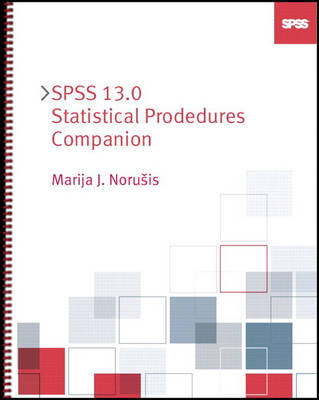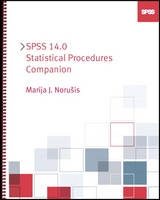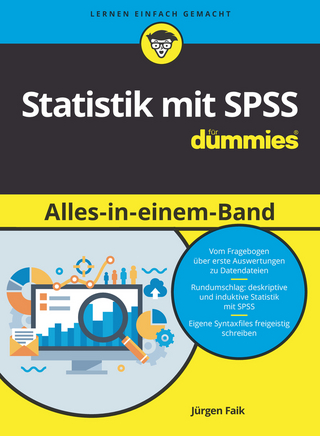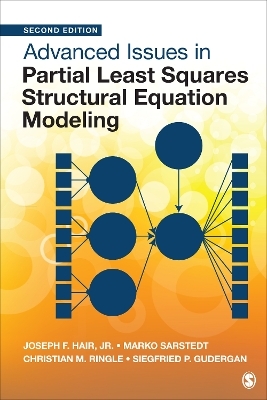
SPSS 13.0 Statistical Procedures Companion
Pearson (Verlag)
978-0-13-186539-6 (ISBN)
- Titel erscheint in neuer Auflage
- Artikel merken
Part 1
1 Introduction
Statistical Procedures Described in the Book. Descriptive Statistics. Compare Means. General Linear Model. General Loglinear Analysis. Correlate. Regression. Classify. Data Reduction. Scale. Nonparametric Tests.
2 Getting to Know SPSS
In a Nutshell. Tutorials. Windows of SPSS. Inside a Dialog Box. SPSS Viewer. Getting More Help. Dressing Up Your Output. Editing Your Charts. Using Syntax.
3 Introducing Data
Vocabulary. Planning the Data File. Getting Data into SPSS. Using SPSS Data Files. Using Spreadsheet and Database Files. Feeding Text Files to the Text Wizard. Typing Your Own Data. Entering the Data. Saving the Data File. Entering Tabulated Data. Creating New Variables. Saving Time When Dealing with Your Data. Selecting Cases for Analyses. Repeating the Analysis for Different Groups of Cases.
4 Preparing Your Data
Checking Variable Definitions. Using the Utilities Menu. Using Define Variable Properties. Checking Your Case Count. Eliminating Duplicate Cases. Adding Missing Cases. Checking Data Values. Listing the Values. Making Frequency Tables. Looking At the Distribution of Values. Looking At Combinations of Variables. Caution.
5 Transforming Your Data
Computing a New Variable. One Size Fits All: Unconditional Transformation. If and Then: Conditional Transformations. Working with the Visual Bander. Changing the Coding Scheme. Checking the Recode. Changing a String Variable to a Numeric Variable. Ranking Variables. Counting Occurrences.
6 Describing Your Data
Examples. In a Nutshell. Newspaper Reading: The Example. Examining Tables and Charts of Counts. Examining Two-Way Tables of Counts. Summarize Scale Variables. Histograms. Variability and Central Tendency. Plotting Pairs of Variables. Creating OLAP Cubes. Percentiles. Normal Distribution. Standard Scores. Navigating the Menus. Obtaining the Output.
7 Testing Hypotheses
In a Nutshell. Setting the Stage. Defining Samples and Populations. Using Random Samples. Creating a Good Experimental Design. Dealing with Missing Data. Testing a Hypothesis. Step 1: Specifying the Null Hypothesis and th. Alternative Hypothesis. Prelude to the Remaining Steps. Step 2: Selecting the Appropriate Statistical Procedure. Step 3: Checking Whether Your Data Meet th. Required Assumptions. Step 4: Assuming That the Null Hypothesis Is True. Step 5: Calculating the Observed Significance Level. Step 6: Deciding Whether to Reject the Null Hypothesis. Calculating Confidence Intervals. Reporting Your Results Correctly. To Err Is Statistical. Commonly Used Tests for Popular Hypotheses. Obtaining the Output.
8 T Tests
In a Nutshell. Deciding Which T Test to Use. One-Sample T Test. Paired-Samples T Test. Two-Independent-Samples T Test. Analyzing Truancy Data: The Example. One-Sample T Test. Paired-Samples T Test. Two-Independent-Samples T Test. Obtaining the Output.
9 One-Way Analysis of Variance
Examples. In a Nutshell. Anorexia: The Example. Arranging the Data. Examining the Data. Checking the Assumptions. Testing the Hypothesis. Analyzing Change. Pinpointing the Differences. Atoning for Many Comparisons. Contrasts: Testing Linear Combinations of Means. Obtaining the Output.
10 Crosstabulation
Examples. In a Nutshell. Chi-Square Test: Are Two Variables Independent. Is It in the Stars. Are Proportions Equal. Measuring Change: McNemar Test. How Strongly Are Two Variables Related. Measures of Association for Nominal Variables. Proportional Reduction in Error Measures. Ordinal Measures. Eta Coefficient. Measures Based on Correlation Coefficients. Measuring Agreement. Measuring Risk in 2-by-2 Tables. Measuring the Relative Risk. Calculating the Odds Ratio. Stratifying the Cases. Testing Hypotheses about the Odds Ratios. Megatip: Entering Tables Directly. Obtaining the Output.
11 Correlation
Examples. In a Nutshell. Body Fat: The Example. Plotting the Data. Examining the Scatterplot Matrix. Using the Pearson Correlation Coefficient. Testing Hypotheses about Correlation Coefficients. Comparing Two Indexes. Basing Correlation Coefficients on Ranks. Using Partial Correlation Coefficients. Calculating Partial Correlation Coefficients. Testing Hypotheses about Partial Correlation Coefficients. Steps for Calculating the Partial Correlation Coefficient. Missing Values. Megatip: Identifying Points in a Scatterplot. Labeling Individual Points with the Default Variable Value. Labeling All Points with the Default Variable Value. Changing the Variables Used to Identify Points. Obtaining the Output.
12 Bivariate Linear Regression
Examples. In a Nutshell. Predicting Body Fat: The Example. Plotting the Values. Calculating the Least-Squares Regression Line. Predicting Body Fat. Determining How Well the Line Fits. Testing Hypotheses about the Population Regression Line. Searching for Violations of Assumptions. Looking for Unusual Points. Dealing with Violations of the Assumptions. Coaxing a Nonlinear Relationship to Linearity. Coping with Non-Normality. Stabilizing the Variance. Adding More Circumferences: Multiple Linear Regression. Obtaining the Output.
13 Multiple Linear Regression
Examples. In a Nutshell. Reading Scores: The Example. Formulating the Problem. Multiple Linear Regression Model. Before You Start. Estimating the Coefficients of the Model. Assumptions for Testing Hypotheses. Regression Hypotheses. Including Categorical Variables. Comparing Two Models: Change in R-Square. Many Paths Lead to the Same Hypothesis. Using an Automated Method for Building a Model. Examining the Methods. Stepwise Selection: An Example. Calculating Predicted Values. After the Model Is Selected. Checking for Violations of Regression Assumptions. Calculating Residuals. Looking for Unusual Observations. Identifying Large Residuals. Identifying Unusual Values of Independent Variables. Looking for Influential Points. Partial Regression Plots. Looking for Collinearity. A Final Comment. Obtaining the Output.
14 Discriminant Analysis
Examples. In a Nutshell. Predicting Internet Use: The Example. Before You Start. Examining Descriptive Statistics. Calculating the Discriminant Function. Discriminant Function Coefficients. Testing Hypotheses about the Discriminant Function. Testing Assumptions. Testing Equality of Discriminant Function Means. Classifying Cases into Groups. Classification Summary. Examining the Probability of Group Membership. Automated Model Building. Setting Criteria. Following the Steps. Classification Results. Discriminant Analysis with Four Groups. Discriminant Function Coefficients. Testing Equality of Discriminant Function Means. Pairwise Differences between Groups. Classification. Classification Function Coefficients. Obtaining the Output.
15 Logistic Regression Analysis
Examples. In a Nutshell. Introduction. Logistic Regression Model. Predicting Node Involvement: The Example. Coefficients for the Logistic Model. Calculating a Predicted Probability. Interpreting the Logistic Coefficients. Testing Hypotheses about the Model. Likelihood-Ratio Test. Are All Coefficients Zero. Model Change. Summary Measures. Tests for a Coefficient. Categorical Variables. Creating Interaction Terms. Evaluating Linearity. Automated Model Building. Variable Entry and Removal Criteria. Examining the Model. Logistic Regression Diagnostics. Model Discrimination. Model Calibration. Diagnostic Statistics for Individual Cases. Related Procedures. Obtaining the Output.
16 Cluster Analysis
Examples. In a Nutshell. Introduction. Hierarchical Clustering. Figure-Skating Judges: The Example. How Alike (or Different) Are the Cases. How Should Clusters Be Combined. Summarizing the Steps: The Icicle Plot. Clustering Variables. K-Means Clustering. Roman Pottery: The Example. Locations of the Pottery. Two-Step Cluster. Clustering Newspaper Readers: The Example. Obtaining the Output.
17 Factor Analysis
Examples. In a Nutshell. Getting Ahead: The Example. Step 1: Computing the Observed Correlation Matrix. Are the Variables Related. Step 2: Estimating the Factors. What’s the Model. How Many Factors Do You Need. Goodness-of-Fit Test. Selecting a Factor Extraction Method. How Are the Variables and Factors Related. How Much Variance Is Explained. Step 3: Making Factors Easier to Interpret: Rotation. Examining the Basics of Rotation. Orthogonal Rotation of Getting-Ahead Data. Plotting the Factors. Oblique Rotation of Getting-Ahead Data. Step 4: Computing Factor Scores. Methods for Calculating Factor Scores. Using Factor Scores to Test Hypotheses. Megatip: Entering a Correlation Matrix. Obtaining the Output.
18 Reliability Analysis
Examples. In a Nutshell. Anomie: The Example. How Are the Individual Items Related to the Overall Score. Reliability Coefficients. Internal Consistency: Cronbach’s Alpha. Split-Half Reliability Model. Guttman’s Lower Bounds. Testing Hypotheses about Scales. Parallel and Strictly Parallel Models. Cochran’s Q: Testing Equality of Related Proportions. Testing Equality of Related Means. Tukey’s Test of Nonadditivity. Measuring Agreement. Intraclass Correlation Coefficients. Obtaining the Output.
19 Nonparametric Tests
Examples. In a Nutshell. Using the One-Sample Chi-Square Test. Do Triplicities Recruit Members? The Example. Using the Binomial Test. Testing Randomness: The Runs Test. Testing Hypotheses about Two Related Groups. Looking at the Sign Test. Adding Power: The Wilcoxon Test. Testing Hypotheses about Two Independent Groups. Wilcoxon Test. Wald-Wolfowitz Runs Test. Testing Hypotheses about Three or More Independent Groups. Kruskal-Wallis Test. Median Test. Three or More Related Groups. Looking for Differences: The Friedman Test. Measuring Agreement: Kendall’s W. Testing Equality of Proportions: Cochran’s Q. Obtaining the Output.
20 General Loglinear Analysis
Examples. In a Nutshell. Origins of Data. Poisson Distribution. Multinomial Distribution. Anatomy of a Loglinear Model. Dissecting a Table. Model Types. Fitting a Saturated Model. Examining the Lambda Parameters. Interpreting the Parameters. Calculating Expected Values. Fitting an Unsaturated Model. Results from the Saturated Model. Determine How Well the Model Fits. Overall Goodness-of-Fit Tests. Residuals. Models for Ordinal Data. Job Satisfaction and Income. Types of Models. Linear-by-Linear Association Model. Fitting Row- and Column-Effects Models. Incomplete Tables. Testing Quasi-Independence. Defining Structural Zeros. Tests for Square Tables. Testing for Symmetry. Two-Dimensional Representations. Poisson Regression: Modeling Rates. Smoking Duration, Intensity, and Death. Goodness of Fit. Interpreting Parameter Estimates. Standardizing Tables. Fitting Homogeneous Margins. Fitting Arbitrary Marginals.
Part 2
21 GLM Univariate
Regression Model with Two Independent Variables. Two-Way Analysis of Variance (ANOVA) with Equal Sample Sizes. Univariate ANOVA: A Randomized Complete Block Design with Two Treatments. Univariate ANOVA: A Randomized Complete Block Design with Empty Cells. Analysis of Covariance (ANCOVA) and Nesting Using the Interaction Operator. Mixed-Effects Nested Design Model. Univariate Repeated Measures Analysis Using a Split-Plot Design Approach.
22 GLM Multivariate
Multivariate ANOVA: Multivariate Two-Way Fixed-Effects Model with Interaction.Profile Analysis: Setting Up Custom Linear Hypotheses.
23 GLM Repeated Measures
Repeated Measures Analysis of Variance. Checking Assumptions. Testing Hypotheses. Doubly Multivariate Repeated Measures Analysis of Variance.
Bibliography
Index
| Erscheint lt. Verlag | 9.6.2005 |
|---|---|
| Zusatzinfo | Illustrations |
| Sprache | englisch |
| Maße | 188 x 230 mm |
| Gewicht | 935 g |
| Themenwelt | Mathematik / Informatik ► Mathematik ► Computerprogramme / Computeralgebra |
| ISBN-10 | 0-13-186539-0 / 0131865390 |
| ISBN-13 | 978-0-13-186539-6 / 9780131865396 |
| Zustand | Neuware |
| Informationen gemäß Produktsicherheitsverordnung (GPSR) | |
| Haben Sie eine Frage zum Produkt? |
aus dem Bereich



